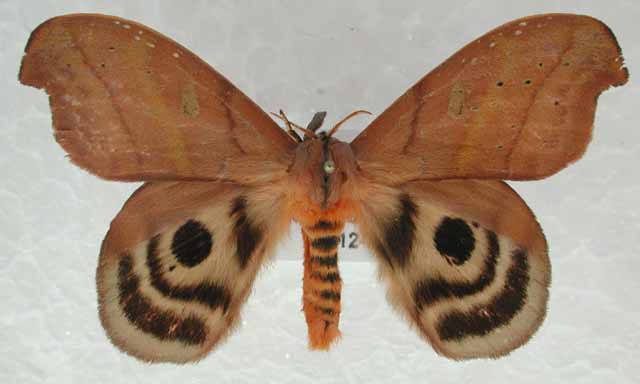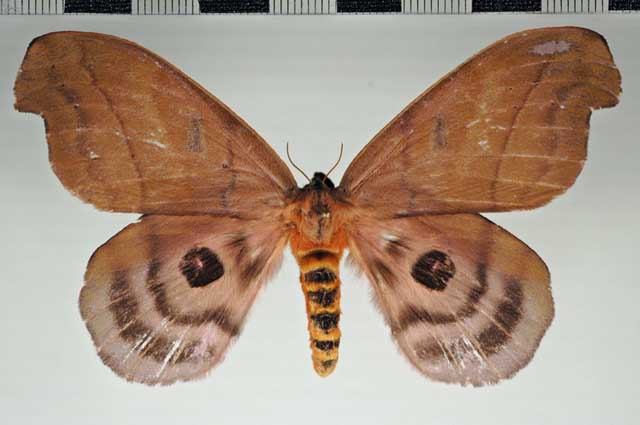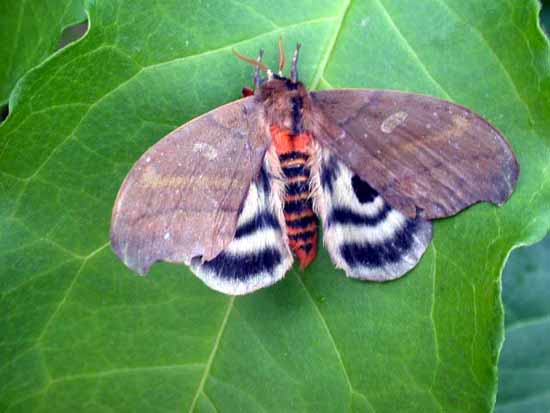Hyperchiria aniris
|
|
Updated as per Lemaire's Hemileucinae 2002, January 15, 2008
|
Hyperchiria aniris
(Jordan, 1910)
(Automeris)

Image courtesy of G. Lecourt.
TAXONOMY:
Superfamily: Bombycoidea, Latreille, 1802
Family: Saturniidae, Boisduval, [1837] 1834
Subfamily: Hemileucinae, Grote & Robinson, 1866
Tribe: Hemileucinae, Grote & Robinson, 1866
Genus: Hyperchiria, Hubner, [1819]
|
MIDI MUSIC
"Someone to Watch
Over Me"
copyright C. Odenkirk
MIDI CITY
ON.OFF
<bgsound src="watch.mid" LOOP=FOREVER>
|
DISTRIBUTION:
Hyperchiria aniris
(wingspan: males: 56-72mm; females: 78-92mm / forewing length:
males: 30-34mm; females: 39-47mm) flies in
tropical rain forest in
Guyana: Cuyuni-Mazaroni,
Potaro-Siparuni, probably Upper Demerara-Berbice and
northern East Berbice-Corentyne; and
French Guiana: Saint-Georges,
Kaw, Roura, Regina, Cayenne, Coralie, Saint-Laurent-du-Maroni,
Saint-Jean-du-Maroni, Saul; and
probably in Surinam.

Hyperchiria aniris (male), French Guiana, courtesy of
Eric van Schayck.
FLIGHT TIMES AND PREFERRED FOOD PLANTS:
There are
probably at least four generations annually with peak flights in
January-February, April-May, July-August, November-December.
Larvae of Hyperchiria aniris eat Robinia pseudoacacia
in captivity.

Hyperchiria aniris female, Kaw, French Guiana,
July 2002, Robert Vande Merghel, French Guiana
Saturniidae.
ECLOSION, SCENTING AND MATING:
Males use well-developed antennae to seek out females which scent
at night. Females are active from 10:00 pm until midnight; males are
active from 10:30 pm until 1:00 am.

Hyperchiria
aniris courtesy of
Entomo Service
EGGS, LARVAE, COCOONS AND PUPAE:
Typical
of species in the Genus Hyperchiria and the
Subfamily Hemileucinae, the larvae are armed with urticating spines.
|
|
Larval Food Plants
Listed below are primary food plant(s) and alternate food plants listed in Stephen E.
Stone's Foodplants of World Saturniidae. It is hoped that this
alphabetical listing followed by the common name of the foodplant will
prove useful. The list is not exhaustive. Experimenting with closely
related foodplants is worthwhile.
Robinia pseudoacacia.......
|
Black locust/False acacia
|
Use your browser "Back" button to return to the previous page.
Return to Hyperchiria genus
Return to South American Saturniidae Directory
Return to Main Saturniidae Index
The following image(s) may or may not appear on your monitor,
depending upon whether or not I get permission from respective
photographers/owners to display them. I do have permission for
my own private use.

Hyperchiria aniris male, Paul Isnard, French Guiana,
December 18, 1998, Philippe Collet, French Guiana
Saturniidae.





